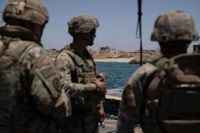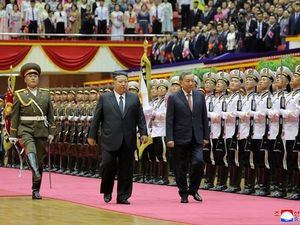In a move that underscores the international community’s renewed push for stability in the Middle East, the United States has announced the deployment of approximately 200 military personnel to Israel. Their mission? To support and monitor the recently brokered Gaza ceasefire deal, a development that comes after two years of relentless conflict and humanitarian devastation in the region.
According to AP, the U.S. Central Command (CENTCOM) will establish a civil-military coordination center in Israel, designed to facilitate the flow of humanitarian aid and provide logistical and security assistance to Gaza. The center will also play a crucial role in overseeing the implementation of the ceasefire agreement, marking one of the first times the U.S. military has taken such a direct role in monitoring a peace deal in the region.
Senior U.S. officials, who spoke to multiple outlets on condition of anonymity, emphasized that no American troops would enter Gaza itself. Instead, the team—comprised of experts in transportation, planning, security, logistics, and engineering—will operate from Israel or possibly Egypt, depending on ongoing diplomatic discussions. As reported by The Times of Israel, the precise location of the command center remains under consideration, with some officials suggesting Egypt may be a more practical host due to its established diplomatic ties with all parties involved.
Joining the American contingent will be military officials from Egypt, Qatar, Turkey, and the United Arab Emirates. This multinational force is intended not only to bolster the legitimacy of the monitoring mission but also to reassure regional actors—including Hamas—of the seriousness of international commitments to the ceasefire. A senior U.S. official explained to France 24, “The notion is to make it collegial, if you will. And the Israelis will obviously be in constant touch with them.”
Admiral Brad Cooper, the head of U.S. Central Command, has been tapped to lead the American team. His involvement has reportedly provided a sense of confidence and security to Arab nations at the negotiating table. “Putting Admiral Cooper in the room gave a lot of confidence and security to the Arab countries,” a senior official told The Times of Israel. “And therefore it was passed on to Hamas that we were taking a very strong role, or the president was taking a very strong position in standing behind his guarantees and his commitments here.”
President Donald Trump, who played a central role in brokering the peace deal, publicly praised Admiral Cooper during a Cabinet meeting at the White House. Trump highlighted the admiral’s efforts alongside special envoy Steve Witkoff, his son-in-law Jared Kushner, and Secretary of State Marco Rubio. “Cooper—I hear he’s been fantastic,” Trump remarked, according to AP.
The ceasefire agreement itself, approved by the Israeli government on October 9, 2025, came after intense pressure from the United States and regional mediators. The deal’s first phase calls for the release of the remaining Israeli hostages within days, in exchange for the liberation of hundreds—potentially close to 2,000—Palestinian prisoners held by Israel. Additionally, the agreement stipulates a pullback of Israeli Defense Forces from Gaza, a move intended to create space for a transition toward civilian governance in the territory.
While the headlines herald a diplomatic breakthrough, the details of implementation remain complex. The civil-military coordination center, staffed by U.S. and partner-nation personnel, is expected to play a vital role in not only monitoring the ceasefire but also in assisting with the transition to a civilian government in Gaza. “The new team will help monitor implementation of the ceasefire agreement and the transition to a civilian government in Gaza,” a U.S. official told AP.
U.S. troops began arriving in the region around October 10, 2025, with more expected over the weekend. Admiral Cooper assured negotiators during talks in Egypt that he could have the command post operational within two and a half weeks—a timeline that reflects both urgency and the logistical challenges ahead.
Yet, this international intervention is not without its critics and skeptics. According to France 24, senior Hamas official Osama Hamdan has stated that “no Palestinian accepts disarming and Palestinians were in need to weapons and resistance.” This sentiment underscores the deep-seated mistrust and the formidable obstacles facing any long-term peace effort in Gaza.
Further complicating the picture, exiled Gaza chief Khalil al-Hayya claimed that Hamas had received guarantees from the United States, Arab mediators, and Turkey that the war on Gaza had permanently ended. Meanwhile, President Trump assured the public that no one in Gaza would be forced to leave the territory under his peace plan, a point of contention in previous negotiations.
The American team’s mandate is clear: oversee, observe, and ensure there are no violations of the ceasefire. Their presence is also designed to integrate with other security forces—including those from Egypt, Qatar, Turkey, and the UAE—to “deconflict” with the Israeli Defense Forces and prevent misunderstandings or escalations. As one senior U.S. official put it, “The US personnel were intended to help create the joint control center and then integrate all the other security forces that will be going in there to deconflict with the IDF.”
As the troops settle in, questions linger about the future of Gaza. The ceasefire deal leaves unresolved issues such as the disarmament of Hamas, the withdrawal of Israeli forces, and the establishment of a new governing authority in the territory. The U.S.-led coordination center is expected to play a role in navigating these transitions, but the path forward remains fraught with uncertainty.
For now, the deployment of U.S. troops—alongside regional partners—signals a renewed international commitment to peace and stability in Gaza. The coming weeks will test the durability of the ceasefire and the ability of this multinational force to manage both the logistical and political complexities on the ground.
As the dust settles on the latest round of negotiations, all eyes are on the region to see whether this carefully crafted ceasefire can hold—and whether the international community’s latest gambit will finally bring lasting peace to Gaza.





